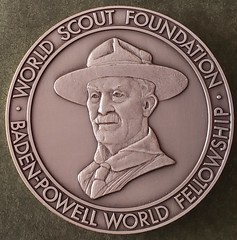VOCABULARY TERM: CONCAVED EDGE
Dick Johnson submitted this entry from his Encyclopedia of Coin and Medal Terminology. George Cuhaj kindly provided images of a World Scout Foundation Baden-Powell World Fellowship medal exhibiting this type of edge. Thanks! -Editor

Concaved Edge. A shallow furrow around the edge of a medal, creating an artistic notched effect. It has an additional and utilitarian purpose of aiding the fingers to pick up and hold the numismatic item with such an edge. An example of concaved edge was the 4-inch Woolworth 50th Anniversary Medallion of 1929 by Julio Kilenyi and struck by Whitehead & Hoag. A type of concave edge with a V-shaped furrow is called contorniate. An anomaly of trimming can create a concaved edge; an example was a James Cardinal Gibbons Medal of 1911 which had an uneven furrow cut in the edge due to improper turning on the lathe, and should have been rejected. (J&J 26:688). See edge.
George adds:
Note that you can still see the horizontal lathe trim lines. The Medal is 70mm silver. Struck by Huguenin (Now Faude + Huguenin, located in La Locle, Switzerland) (The FIDEM Congress of 1998 had a great floor tour of this facility). Given with a certificate to donors of $10,000 USD or more (in one lump sum or total thereof spread over 5 years) to the World Scout Foundation.

